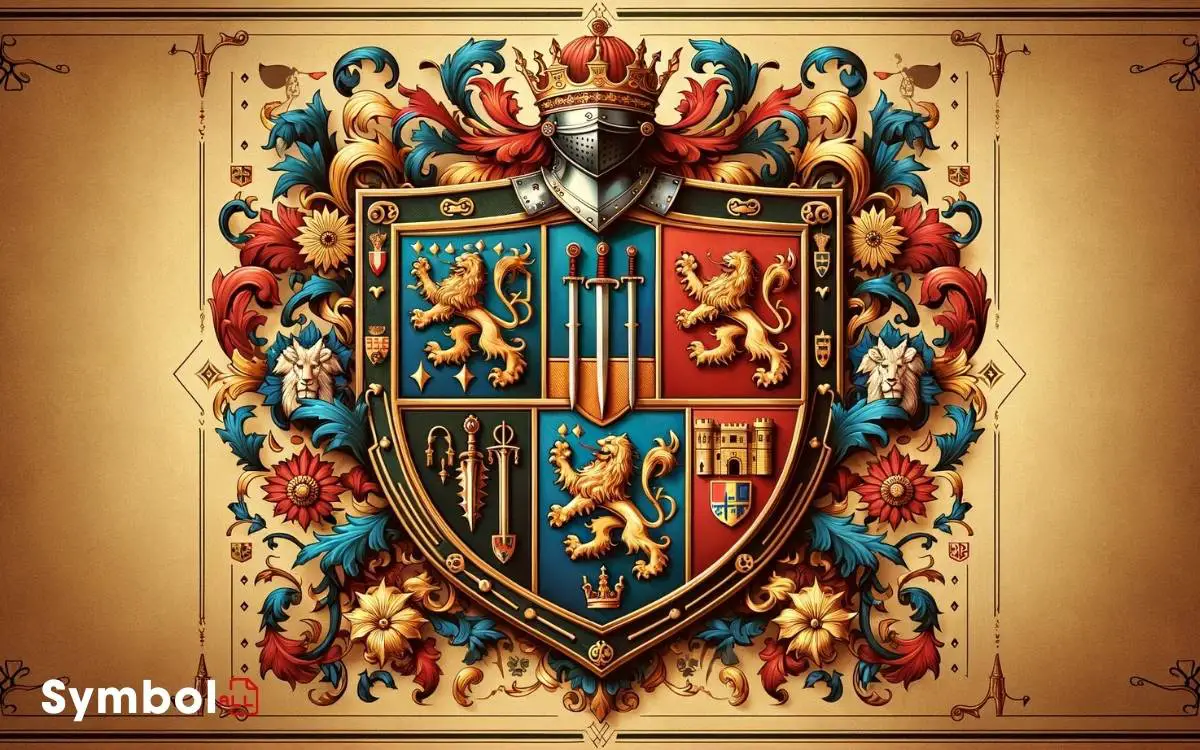What Are the Traditional Colors and Symbols on a Shield?
In heraldry, shields aren’t just defenses; they’re a canvas for identity, etching lineage, and allegiances in color and symbol. Gold and silver sing of wealth, peace, and purity, while bolder hues like red and blue declare bravery and loyalty.
Green and black whisper tales of renewal and endurance, with purple marking the regal. Creatures, too, bear meaning: lions roar with authority, bears guard resilience, and mythical beasts, from dragons to unicorns, symbolize strength and purity.
Each emblem, each tint, isn’t just exploration but a coded message of heritage and honor. As you investigate further, you’ll uncover a world where every detail adds to the story.

Key Takeaways
The Role of Heraldry
Heraldry, with its intricate system of symbols and colors, plays a pivotal role in exploring lineage and signifying alliances among nobility.
As you investigate into this subject, you’ll find that each symbol and motif woven into a coat of arms serves as a coded language, offering insights into a family’s history, achievements, and virtues.
These emblems, passed down through generations, aren’t merely decorative. They’re steeped in history, each bearing a unique significance and story.
The practice of heraldry emerged as a systematic method for knights and nobles to identify themselves in battle and in ceremonial events, growing into a complex art form that codifies identity, authority, and familial bonds.
Understanding these symbols provides a window into the social and political fabric of the past, allowing one to appreciate the depth and breadth of noble heritage.
Understanding Shield Colors
You must appreciate the profound significance shield colors held in historical contexts, as each hue conveys specific attributes and societal values.
Common shield hues, ranging from bold reds to deep blues, weren’t merely aesthetic choices but were imbued with layers of meaning.
Understanding these colors’ symbolic importance offers insights into the cultural and martial ethos of the era.
Shield Color Significance
In the domain of traditional shields, each hue holds a distinct and symbolic significance, guiding the observer through a nuanced understanding of the bearer’s identity and values.
This intricate tapestry of colors isn’t merely aesthetic; it’s a coded language from an era when symbols and hues conveyed as much as words.
| Color | Significance |
|---|---|
| Red | Valor and bravery |
| Blue | Loyalty and truth |
| Green | Hope and joy |
The understanding of these colors within the context of heraldry allows for a deeper appreciation of historical narratives and the personal stories of those who bore these shields.
It’s a fascinating study that provides insight into the cultural and personal symbolism that was so pivotal in the age of heraldry.
Common Shield Hues
Exploring the domain of typical shield colors, it’s essential to understand that each shade isn’t simply a selection of pigment but a purposeful choice infused with profound historical significance and symbolism.
Let’s dive into the nuances of these hues:
- Red: Often symbolizing courage and valor, red on a shield signifies a warrior’s readiness to sacrifice for their cause or country. It’s a declaration of strength and bravery.
- Blue: This color represents loyalty, truth, and faithfulness. A shield adorned in blue suggests a commitment to these virtues, offering protection under the banner of honesty and trust.
- Gold (Yellow): Symbolic of generosity and elevation of the mind, gold hues on shields reflect the noblest of intentions, signifying respect, virtue, and the pursuit of enlightenment.
Understanding these colors enhances your grasp of the symbolic language heraldry communicates, revealing the depth of tales carried by these ancient insignias.
Gold: Wealth and Generosity
Symbolizing wealth and generosity, gold has long been a prestigious color in the heraldic tradition, representing not only material wealth but also the generous spirit of those it adorns.
This noble hue, often associated with the sun, conveys a sense of enlightenment and divinity, suggesting that the bearer not only possesses substantial resources but is also willing to share them with others.
The use of gold in heraldry speaks to a legacy of benevolence and nobility, positioning its bearers as both prosperous and magnanimous.
| Emotion | Symbolized by Gold |
|---|---|
| Pride | Material Success |
| Joy | Generosity Shared |
| Awe | Divine Connection |
| Respect | Noble Legacy |
| Hope | Enlightened Future |
Silver: Peace and Sincerity
Reflecting a deep sense of peace and sincerity, silver stands as a cornerstone in heraldic symbolism, denoting not only purity and clarity but also an unwavering commitment to honesty and integrity.
In the domain of heraldry, the color silver or argent as it’s traditionally known carries with it a profound significance:
- Representation of Nobility: Silver symbolizes a noble lineage, emphasizing the bearer’s virtuous qualities and the lofty ideals they aim to embody.
- Emblem of Tranquility: The luminous quality of silver is associated with the calm and soothing nature of peace, suggesting a shield bearer’s predisposition towards diplomacy and reconciliation.
- Symbol of Sincerity: It underscores the importance of sincerity in one’s actions and words, reflecting a true and earnest approach to life’s challenges and interactions.
In embracing silver, one showcases a dedication to living a life marked by genuine intentions and peaceful resolutions.
Red: Warrior and Martyr
Red, the color of blood and fire, conveys a powerful message of bravery and sacrifice, marking its bearers as warriors and martyrs throughout history.
When you see red on a shield, it’s not merely a choice of palette; it’s a declaration of the bearer’s readiness to fight to the last breath and, if necessary, to lay down their life for their cause.
This color, deeply embedded in human history, symbolizes the life force, valor, and the profound commitment to a purpose worth the ultimate price.
In heraldry, red, or ‘gules’ as it’s traditionally known, commands respect and warns adversaries of the fierce spirit and unyielding courage of those it represents. It’s a proof to their willingness to endure hardship and face death with honor.
Blue: Loyalty and Truth
Shifting our focus to the serene yet profound hue of blue, it’s imperative to understand that this color embodies unwavering loyalty and the pursuit of truth, setting a distinct tone on the battlefield and in the hearts of those it represents.
The symbolism of blue on shields is multifaceted:
- Historical Significance: Blue has been a long-standing symbol in heraldry, representing steadfastness in the face of adversity.
- Psychological Impact: It instills a sense of calm and stability, crucial in tumultuous times.
- Cultural Interpretation: Across various cultures, blue signifies trustworthiness and reliability, essential traits for allies and leaders alike.
Understanding the depth of blue’s symbolism enriches your appreciation for the strategic use of colors in heraldic traditions.
Green: Hope and Joy
Shifting to the luxuriant shade of green, it’s crucial to acknowledge its representation of hope and joy in heraldic traditions.
In the domain of heraldry, green, or vert, isn’t simply a color; it’s a potent symbol that conveys a profound message about the bearer’s values and aspirations.
This verdant hue, reminiscent of spring’s renewal and the natural world’s vibrancy, has historically been associated with growth, fertility, and the promise of new beginnings.
When you encounter a shield adorned with green, you’re not just seeing a decorative choice. You’re witnessing a declaration of the bearer’s optimistic outlook and their commitment to fostering life, prosperity, and happiness.
It’s a confirmation of their belief in the potential for renewal and positive change, making green an emblem of both personal and communal aspiration.
Black: Constancy and Grief
In heraldic traditions, black, often referred to as sable, symbolizes constancy and grief, imbuing shields with a solemn depth that speaks to the endurance and mourning of the bearer.
This hue carries significant importance within the heraldic spectrum, offering a visual representation of unwavering loyalty and the profound impact of loss.
- Symbol of Endurance: Black’s association with constancy reflects a bearer’s steadfastness amidst adversity, suggesting an unyielding fortitude.
- Representation of Mourning: The color’s link to grief provides a poignant reminder of mortality and the solemn respect for those passed.
- Versatility in Design: Despite its somber implications, black serves as a powerful contrast in heraldry, enhancing the visibility and impact of other colors and symbols on the shield.
This sophisticated application of black demonstrates its crucial role in conveying complex emotional and ethical narratives within heraldry.
Purple: Royal Majesty
Moving from the solemn depths of black, we now explore the regal elegance of purple, a color historically reserved for royalty and symbolizing sovereign majesty in heraldic traditions.
This hue, often associated with wealth and power, was once so costly to produce that only the highest echelons of society could afford garments dyed in it.
In the context of heraldry, purple’s presence on a shield isn’t just an indicator of nobility, but it also conveys a sense of wisdom, dignity, and piety. It’s a color that commands respect, embodying the gravitas and responsibility inherent to ruling.
When you encounter purple on a shield, you’re not merely seeing a color; you’re witnessing a tribute to the lineage and the esteemed virtues of the bearer.
Symbols of Strength and Courage
You’ll find that symbols of strength and courage have long been integral to the imagery on traditional shields, each carrying a unique connotation.
The lion, for instance, embodies regal power, signifying not just physical might but also sovereign authority.
Conversely, the bear represents raw strength and the sword, bravery embodied, illustrating a warrior’s readiness to confront challenges head-on.
Lion: Regal Power
Throughout history, the lion has symbolized strength and courage, often gracing the shields of warriors and empires as a demonstration of their regal power.
This majestic beast isn’t chosen at random; its presence on a shield conveys specific virtues and a message of formidable authority.
Here’s why the lion stands out:
- Symbol of Sovereignty: The lion, often dubbed the ‘king of beasts,’ epitomizes supreme power and authority, mirroring the status of the bearer.
- Embodiment of Courage: Its fearless nature in the face of danger underscores the bearer’s bravery in battle.
- Representative of Nobility: The lion’s dignified bearing and majestic mane reflect nobility, suggesting the bearer’s noble lineage or esteemed character.
These attributes make the lion an unparalleled symbol of regal power on shields, speaking volumes about the wearer’s strength and courage.
Bear: Raw Strength
Just as the lion stands as a symbol of regal power, the bear embodies raw strength and indomitable courage on the battlefield.
Throughout history, warriors and leaders have adorned their shields with the image of a bear to signify not only physical power but also resilience and protection.
This majestic creature, known for its formidable presence and fearless spirit, serves as a profound emblem of the warrior’s own unyielding force and bravery.
In heraldry, the bear’s depiction often includes standing on hind legs, ready to defend, highlighting its readiness and steadfast resolve.
This symbol communicates to allies and adversaries alike that the bearer possesses unmatched strength and the heart of a warrior, unwavering in the face of danger.
Sword: Bravery Embodied
In the records of history, few symbols have resonated with the essence of bravery as profoundly as the sword, embodying the warrior’s courage and valor in the face of adversity.
As you explore further into the symbolism of the sword on shields, you’ll uncover its multifaceted significance:
- Representation of Authority: The sword symbolizes the bearer’s right to lead and make decisive actions during conflicts.
- Symbol of Justice: It mirrors the concept of the sword of justice, signifying the holder’s commitment to fairness and the protection of the innocent.
- Emblem of Sacrifice: Demonstrating the willingness to sacrifice one’s life for a greater cause, the sword illustrates the ultimate form of bravery.
This symbol, then, isn’t simply a weapon but a powerful attestation to the character and ideals of its wielder.
Animals in Heraldry
Animals have long served as powerful symbols in heraldry, each carrying distinct meanings that reflect the values and characteristics of the bearers. Lions, emblematic of courage and strength, often grace the shields of those claiming authority and bravery.
Eagles, soaring high with keen vision, symbolize perspicacity and power, chosen by those who value freedom and foresight. The bear, with its formidable presence and endurance, represents protection and resilience, a guardian for the family lineage.
Deer, graceful and vigilant, denote harmony with nature and spiritual authority. Each animal, whether predator or prey, embodies specific virtues, encapsulating the essence of noble qualities.
Understanding these symbols allows you to grasp the depth of heraldic tradition, a language of imagery where animals narrate tales of valor, wisdom, and heritage.
Mythical Creatures Explained
Outside the domain of the natural world and its fauna, heraldry also embraces a fascinating array of mythical creatures, each with its own profound symbolism and stories.
These beings aren’t mere figments of imagination but serve as potent emblems, encapsulating the virtues, values, and aspirations of those they represent.
- Dragons: Symbolizing strength, wisdom, and protection, dragons are often depicted as guardians of treasures. Their fearsome presence on a shield signifies the bearer’s valor and formidable nature.
- Griffins: Combining the regal lion and the majestic eagle, griffins represent courage, boldness, and vigilance. They underscore a harmonious blend of intellect and physical prowess.
- Unicorns: These elusive creatures symbolize purity, grace, and healing. A unicorn on a shield suggests a noble spirit, untainted by worldly corruption.
Understanding these symbols enriches one’s appreciation of heraldic art, revealing layers of meaning that transcend mere decoration.
The Language of Flowers and Plants
You’ll find that the symbolic meanings of plants have woven a rich tapestry throughout history, serving as vital elements in heraldic traditions.
Floral emblems, deeply ingrained in heraldry, convey specific virtues, allegiances, and familial lineage with precision and clarity.
The cultural impact of vegetative motifs extends beyond mere decoration, encapsulating societal values, beliefs, and historical narratives.
Symbolic Meanings of Plants
Throughout history, the language of flowers and plants has been imbued with profound symbolic meanings, offering insights into cultural values, personal sentiments, and historical contexts.
This intricate language enables you to decode messages woven into art, literature, and heraldry, revealing layers of interpretation that might otherwise go unnoticed.
To grasp the depth of this language, consider these examples:
- Roses: Traditionally symbolize love, beauty, and courage. The color can further refine the meaning; red for love, white for purity, and yellow for friendship.
- Olive Branch: Represents peace and reconciliation. Its appearance in various contexts underscores a universal longing for harmony.
- Laurel: Signifies triumph, honor, and renown. Worn by victors in ancient celebrations, it embodies achievement and glory.
Understanding these symbols enriches your appreciation of historical and contemporary visual narratives, allowing a deeper engagement with the stories they tell.
Floral Emblems in Heraldry
In the domain of heraldry, floral emblems carry deep symbolic meanings, encapsulating the virtues, heritage, and aspirations of those they represent.
Each flower or plant selected for inclusion on a shield isn’t merely for aesthetic appeal; it’s a deliberate choice, conveying specific traits or historical connections.
The rose, for example, often symbolizes love and beauty, but in heraldry, it can also denote honor and faith. Similarly, the lily, traditionally associated with purity and chastity, represents in heraldic terms the noble ideals of charity and hope.
Understanding these emblems requires a grasp of the historical and cultural context from which they originate, offering a nuanced view into the values and identity of the bearer.
Vegetative Motifs Cultural Impact
Building on the understanding of floral emblems in heraldry, we now explore the broader cultural impact of vegetative motifs, uncovering the rich language of flowers and plants that transcends decorative purposes to communicate complex messages and values.
This symbolic language acts as a bridge between cultures, each with its own interpretations and associations:
- Roses signify love and honor, embodying the complexity of human emotions across various cultures.
- Olive branches, universally recognized symbols of peace, underscore humanity’s enduring quest for harmony and reconciliation.
- Oak leaves stand for strength and endurance, echoing the resilience and steadfastness inherent in many societies’ core values.
These motifs aren’t mere adornments; they’re a manifestation of the enduring power of nature to convey profound societal norms and aspirations.
Conclusion
As you explore the vibrant world of heraldry, you’ll discover that the colors and symbols adorning a shield aren’t mere coincidences; they’re a language of their own.
Gold signifies wealth, red marks a warrior, and each animal or mythical creature has a story to tell. Whether it’s the fierce loyalty depicted by a lion or the purity symbolized by silver, these elements craft a narrative of heritage and valor.
Unraveling this ancient code, you connect with the legacies of yore, understanding that every hue and figure on a shield mirrors the profound tales of those who bore them.






